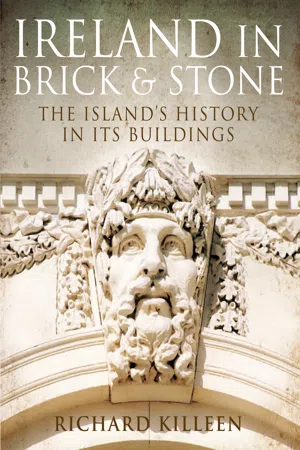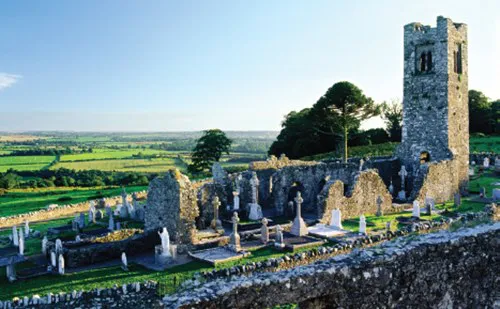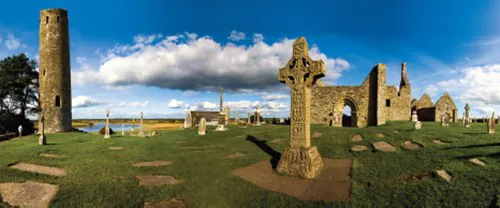![]()
1
SLANE FRIARY
The remains of Slane Friary, on a hill overlooking the modern village of Slane in Co. Meath, can be clearly seen from the road as one approaches
the village from Dublin. This is the main road to Derry and western Ulster. At Slane it crosses the River Boyne just a few miles to the west of Brú na Bóinne — the bend of the
Boyne — where the river turns in a U-shape before resuming its eastward journey to the sea at Mornington. Within the U lie the Neolithic sites of Newgrange, Knowth and Dowth, the first of
these being one of the true wonders of Ireland.
As old as the Egyptian pyramids, Newgrange is a passage tomb, a burial site. It is 11 metres high and over 80 metres in diameter, with a corbelled roof that has kept the interior dry for nearly
four millennia, this in a country with abundant rainfall. A series of gutters carry rainwater to the margins of the tomb, where it runs off harmlessly. The tomb is aligned to
the rising sun on midwinter day, for on that day and that day alone a lightbox over the entrance admits the rays of the sun, just breaking the horizon to the east, to flood the full length of the
entry passage and to strike the back wall of the central burial chamber. The unknown pastoral people who built this and other extraordinary structures long antedated the Celts.
The Celtic peoples who occupied Ireland from about 300 BC and created a common linguistic culture throughout the island also established themselves in this lush river valley and its environs.
This is rich limestone land, perfect for the pastoral rural economy of the Celts, as it had been for all the peoples that preceded them and whom they had obliterated from history. The royal site of
Tara — seat of the kings of the southern Uí Néill — lies just 15 km to the south west. This was a provincial centre of some importance, although its later inflation into
the seat of the high kings of Ireland was a nationalist whimsy: there was no such centralised authority in Celtic Ireland. Tara had been a site of military and strategic importance in pre-Celtic
times, for like Cashel in Munster it commands a stunning view of the flat country all around and is therefore a formidable defensive position. It has evidence of human settlement from as far back
as the 3rd millennium BC.
For all the early inhabitants of Ireland, this was a landscape worth possessing. So it is no surprise that the story of Christianity in Ireland starts here, albeit with what is certainly a
fable. According the legend, St Patrick converted the local king at the hill above Slane to Christianity by showing him a shamrock and explaining that the trefoil leaves in the one plant
represented an image of the unity of the Trinity.
According to the ballad, St Patrick was a gentleman — he came of dacent people. True. He is for the most part a figure of mystery, although the shadow of the real person is discernible.
And this is for a reason: that he is the first figure in the history of the island to leave us a written record of any kind. In his case, he has left us a record of himself, a kind of displaced
autobiography.
Two fragments are all we have, but they are undoubtedly the work of his hand. So, who was he? He was the son of a Romanised British family, born in the early fifth century, who had been captured
by Irish piratical raiders and sold into slavery. His family were Christian, like all the late Roman elite, metropolitan and provincial alike. Having eventually escaped back to Britain, he dreamed
that he was being recalled to Ireland to evangelise the island for Christ.
He was probably not the first Christian missionary in the country but he was certainly one of the most potent. His mission was confined to the northern half of the island: the southern half
contains no verifiable Patrician sites. And the two documents he has left us? The first, and more important, his Confessio, is the text from which we can patch together
the outline of his life. The second, the Letter to Coroticus, is a bitter protest against the depredations of a British chieftain whose troops came ashore in Ireland and slaughtered newly
evangelised Christians, an outrage that Patrick might have felt with particular keenness given his own earlier experience at the hands of the Irish.
So this is the ambiguous man who stands before the sub-king above Slane, some time in the early fifth century, and convinces him of the Trinitarian version of Christianity. Or doesn’t.
Almost certainly, this is the purest myth and there is not a shred of evidence in support of it. Which is important: because the point of Patrick is not that we can prove that he did this or that,
or even that he was the national evangelist, but that he was the first living, breathing human being on the island of Ireland of whom we have a secure record, however tentative. Before him, all is
conjecture, heroic myth and uncertainty. Here is flesh and blood: a real person.
The French have a marvellous phrase, les lieux de mémoire: the sites of memory. Slane is Ireland’s first such site, not because of what happened here (it didn’t) but
because of how it has been remembered. When Patrick converted the king — so the story goes — it was Eastertide, the most sacred moment in the Christian calendar. And here, on the hill
above Slane in the early fifth century, he lit the first Paschal Fire ever seen in Ireland: the light upon a hill that kindled a tradition still living today.
The Hill of Slane is also the site of the earliest documented mention of a round tower, that most distinctive of early Christian structures, in the Irish annals. No trace of it remains, it
having been burned by the Vikings.
The story of Patrick and the Paschal Flame may be a myth, but it is an enabling one. On this site, important since pre-history, occurs the first narrative event in the history of Irish
Christianity. And even if that narrative was fiction, it was no less powerful for that. Here, not long after Patrick, St Erc founded a monastery which subsisted for the best part of a millennium
until the Franciscans established a friary in the early sixteenth century, just a generation or so before friaries and monasteries got it in the neck from Henry VIII. The church there finally
closed as a place of worship in the early eighteenth century, and it is the ruins of this late medieval/early modern ecclesiastical complex that you see from the road as you drive north towards
Slane.
![]()
2
GALLARUS
The far western end of the Dingle peninsula is a heart-stopping landscape. At Dunmore Head, just as the coast road reveals the stunning view of the
Blasket Islands, you are at the most westerly point in Europe: the next parish to America. It is like standing at the outer arms of Sydney Harbour and looking across the Pacific in the knowledge
that beyond that vast expanse of blue there is nothing between you and Santiago in Chile. For Santiago, read Boston, Massachusetts. Actually, if you follow lines of latitude, read the Strait of
Belle Isle that separates the northern tip of Newfoundland from Labrador. But let’s not get too literal.
This is a harsh and unforgiving land, for all its beauty. It is stony, arid and utterly remote. In every sense, it is as far from the lush plains of Co. Meath as it is possible to be on the same
small island. For most of human history, it has been accessible by land only with the greatest difficulty. To this day, access — the demand for which has been ramped up
by tourism — is still confined to narrow, single-carriageway roads. A narrow-gauge railway, itself never commercial, went only as far as Dingle and closed in the 1950s. And here we are 20 km
west of Dingle. Traditionally, the sea was the highway here.
Blasket Sound, the whip of water that separates the mainland from the Great Blasket, is a vicious funnel through which the entire North Atlantic flows. In calm summer weather, it looks like an
idyllic millpond. In winter, it can be a cauldron. Here, in September 1588, three ships of the Spanish Armada, having made a heroic anti-clockwise circumnavigation of the British Isles on the
return journey to Spain, met their end during an apocalyptic autumn storm. Eight years earlier, in 1580, a papal force of 1,000 infantry, sent in support of the Counter-Reformation rebellion of the
Earls of Desmond — whose lands encompassed the peninsula — landed at Smerwick Harbour on the more sheltered northern shore under Mount Brandon. There they built a fort, known then and
ever since as Dún an Óir, the fort of gold. They bore papal letters absolving the Irish lords from allegiance to Queen Elizabeth I and calling for a religious war to secure
Catholicism in Ireland. This was the great ideological fault line of the age. It was all or nothing for both sides, which helps to explain the horrors of the war.
The papal force was trapped at Smerwick by Lord Grey de Wilton, the chief governor, and massacred. The English response to the Desmond rebellion was pitiless: famine, together with wholesale
slaughter of people and livestock. War à l’outrance was the means employed and it reduced the entire earldom, which stretched from this remote western fastness to the rich
plains of central and eastern Munster, to a barren, starving shambles.
A few kilometres inland from Dunmore Head to the south and from Dún an Óir to the north, more or less in the centre of the narrow peninsula, stands the intriguing corbelled
oratory of Gallarus. It is tiny. It looks for all the world like an upturned boat. It dates from around 1000 AD and is one of the best-preserved early Christian buildings in the country. Its
remoteness and its diminutive size may account for the fact that what we see now is what its builder saw when he finished it.
The oratory of Gallarus is completely unmortared. The stones are laid each upon the other with such overlapping precision that it is bone dry inside and has remained so for more than a thousand
years in one of the wettest locations in the northern hemisphere. This ancient corbelling technique had been used since Neolithic times, and had been employed in many of the great pre-historic
burial sites. It is perhaps no surprise that such an enduring construction technique should have been deployed so successfully here three millennia after it had first been perfected on the
island.
It is speculated that the principal function of Gallarus Oratory was as a way station — a place of prayer — on a pilgrimage route, possibly a seaborne route to
the Camino de Santiago de Compostella. Smerwick nearby would have furnished a safe haven along this otherwise forbidding coast.
Gallarus is also redolent of the anchorite tradition in the early Irish Christian church. Because early Christian Ireland had no towns to serve as foci for dioceses, the structure of church
government differed from the norm of Latin Christianity. The Irish church was monastic in structure: the great early monasteries served as proto-towns and proto-universities. But they never
acquired the full sinews of urban life, nor did they develop into universities in the continental sense, as at Bologna and Paris.
Part of the monastic enterprise was a consistent search for purity of spirit, a rejection of the material and a retreat to remote places in pursuit of a spiritual life cleansed of luxury or
wealth. The reform movement in the early Irish church known as the Céile Dé (the Companions of God) were especially remembered for their zealous ascetic excesses, but they were
part of a tradition, not altogether at the margin of the early church, that reappeared on a regular basis. Extremes of fasting, the denial of music and an idealisation of the early desert fathers
drove such rigorists towards remote and barren places like the western edge of the Dingle Peninsula. An even more celebrated and dramatic location was on the Great Skellig Rock, a vast triangular
sea stack 16 km off shore, clearly visible to the south in clear weather.
These were the locations of the Irish ‘desert fathers’, echoing the anchorite ascetics of the early Eastern Church, whose huge influence in early Christianity was later eclipsed by
the eminence of Rome in the west. Indeed, the Irish word ‘dysert’, which occurs in a number of place names around the island, is cognate with the Latin desertus. The excesses of
the ascetics were often lampooned by more orthodox and worldly monastic writers. Not the least of these lampoons is the Navigatio Sancti Brendani Abbatis, otherwise the celebrated Voyage of
St Brendan. A work of fiction, it has been read (and mis-read) as the story of an actual voyage, although some of the details are so plausible that it may be based on the lost account of a voyage
that was actually accomplished.
Although it was written as a theological tract intended to satirise the ascetics, its popular fame came from its metaphor of the voyage and spawned the myth that St Brendan sailed from Brandon
Creek, just below Gallarus, and discovered America in the sixth century. He may or may not have: we shall never know. In the 1970s, the adventurer Tim Severin established that it could have been
done using sixth-century naval technology. It was a possibility — and it is as logical to believe that St Brendan sailed from here and reached North America centuries before the Vikings or
the Basques or Columbus as it is to dismiss it all as whimsy.
![]()
3
CLONMACNOISE
The monastery of Clonmacnoise — one of the most dramatically sited in Ireland — stands on the eastern shore of the River Shannon just below the town of Athlone. Its location is no accident. This is the point at which the principal east–west route in ancient Ireland crossed the Shannon, itself the great north–south artery. (It can never be repeated often enough that water-borne transport was easier than overland until the proper metalling of roads in the early nineteenth century.) It is also close to the provincial boundary between Leinster and Connacht — the river being a very obvious part of that boundary — and as a consequence it drew patronage from both provinces. A number of Connacht kings are buried there.
The foundation is usually dated to the 540s, barely a century after St Patrick. Nothing survives from the early centuries; the buildings were almost certainly timber-built and perishable. Only when stone structures are first erected, from the tenth century, does the site assume the rough appearance with which we are familiar.
The spread of monastic settlements went hand in hand with the spread of literacy, grounded in the centrality of the Bible. Gradually, the influence of literate scholars — most of them initially in holy orders — embraced the secular world of the law. Clerical influence on the law was very marked from the eighth century. The older, customary law was gradually but decisively replaced by written codes. Moreover, it changed in nature, becoming more severe. Traditionally, the unwritten law had permitted material restitution even in some cases of murder. Clerical influence — clearly drawing from Biblical precedents — was much harsher. Kings were now encouraged to eschew...






